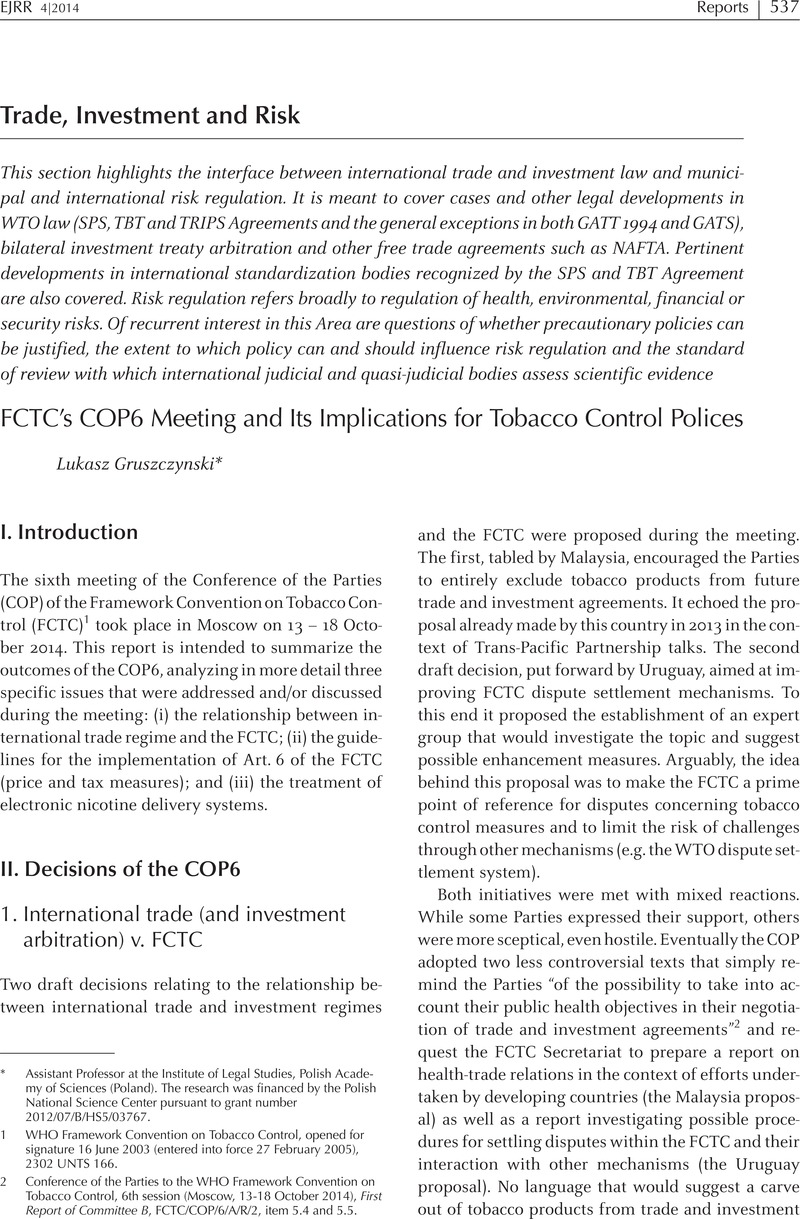No CrossRef data available.
Published online by Cambridge University Press: 20 January 2017

1 WHO Framework Convention on Tobacco Control, opened for signature 16 June 2003 (entered into force 27 February 2005), 2302 UNTS 166.
2 Conference of the Parties to the WHO Framework Convention on Tobacco Control, 6th session (Moscow, 13-18 October 2014), First Report of Committee B, FCTC/COP/6/A/R/2, item 5.4 and 5.5.
3 Conference of the Parties to the WHO Framework Convention on Tobacco Control, Fifth session (Seoul, Republic of Korea, 12-17 November 2012) Summary Records of Committees, FCTC/COP/5/REC/2, p. 156.
4 For an interesting discussion on this issue, see A. Mitchell, T. Voon & D. Whittle, Public Health and the Trans-Pacific Partnership Agreement, Asian Journal of WTO and International Health Policy & Law (2014, forthcoming), available at http://papers.ssrn.com/sol3/papers.cfm?abstract_id=2393670 (last visited 1 November 2014).
5 E.g., Brunnée, J., COPing with Consent: Law-Making Under Multilateral Environmental Agreements, 15(1) Leiden Journal of International Law 1 (2002), p. 32 CrossRefGoogle Scholar.
6 Rules of Procedure of the Conference of the Parties to the WHO Framework Convention on Tobacco Control, available at http://whqlibdoc.who.int/publications/2006/9789241594554_eng.pdf?ua=1 (last visited 1 November 2014) Rule 50.
7 See e.g., Lo, Ch-f., Guidelines and protocols under the framework convention, in Mitchell, A. & Voon, T. (eds.), The Global Tobacco Epidemic and the Law, Edward Elgar Publishing, Cheltenham: 2014, pp. 32–47 Google Scholar.
8 See also, Kwak, K. & Marceau, G., Overlaps and Conflicts of Jurisdiction between the World Trade Organization and Regional Trade Agreements, in: Bartels, L. & Ortino, F. (eds.), Regional Trade Agreement and the WTO Legal System, Oxford University Press, Oxford: 2006, pp. 469-70Google Scholar.
9 Appellate Body Report, Mexico – Tax Measures on Soft Drinks and Other Beverages, WT/DS308/AB/R, adopted 24 March 2006.
10 Note that in the case of the WTO and FCTC even the complaint will be different. The FCTC dispute settlement system is relevant for disputes concerning application and interpretation of the Convention. On the other hand, the WTO counterpart is available for violations of WTO provisions. Although there might be some overlaps between the two regimes (in term of the facts underlying the dispute), both of them relate to different international obligations – not only in a formal sense but also in terms of the substance of those obligations.
11 Appellate Body Report, Mexico – Soft Drink, paras. 51-2.
12 Guidelines for implementation of Article 6 of the WHO FCTC (Price and tax measures to reduce the demand for tobacco), 16 October 2014, FCTC/COP6(5).
13 Set of guiding principles and recommendations for implementation of Article 6 of the WHO Framework Convention on Tobacco Control (Price and tax measures to reduce the demand for tobacco), 17 November 2012, FCTC/COP5(7).
14 All adopted guidelines are available at the official FCTC webpage (http://www.who.int/fctc/guidelines/adopted/en/).
15 World Health Organization, WHO technical manual on tobacco tax administration, WHO, Geneva: 2010 Google Scholar.
16 Conference of the Parties to the WHO Framework Convention on Tobacco Control, 6th session (Moscow, 13-18 October 2014), Second report of Committee A, FCTC/COP/6/A/R/2, item 4.4.2.
17 Conference of the Parties to the WHO Framework Convention on Tobacco Control, 6th session (Moscow, 13-18 October 2014), Provisional agenda item 4.4.2, Electronic nicotine delivery systems, Report by WHO, FCTC/COP/6/10 Rev. 1, 1 September 2014.
18 See e.g., Royal College of Physicians, RCP statement on ecigarettes, available at https://www.rcplondon.ac.uk/press-releases/rcp-statement-e-cigarettes (last visited 1 November 2014); Polosa, R. et al., A fresh look at tobacco harm reduction: the case for the electronic cigarette, 10(19) Harm Reduction Journal 1 (2013), and the literature cited thereinCrossRefGoogle Scholar.
19 Statement from specialists in nicotine science and public health policy, directed to Dr Margaret Chan, 26 May 2014, available at http://nicotinepolicy.net/documents/letters/MargaretChan.pdf (last visited 1 November 2014).
20 See e.g., L.M. Dutra & S. Glantz, Electronic cigarettes and conventional cigarette use among US adolescents: A cross-sectional study, 168 JAMA Pediatrics 610 (2014); R. Grana, Background Paper on E-cigarettes (Electronic Nicotine Delivery Systems), December 2013, available at http://arizonansconcernedaboutsmoking.com/201312e-cig_report.pdf (last visited 1 November 2014).
21 E.g., R. Grana et al., E-cigarettes: A scientific review, 129 Circulation 1972 (2014).
22 Schraufnagel, D.E. et al., Electronic Cigarettes. A Position Statement of the Forum of International Respiratory Societies, 190(6) American Journal of Respiratory and Critical Care Medicine 611 (2014)CrossRefGoogle ScholarPubMed.
23 E.g., International Union Against Tuberculosis and Lung Disease, Position Statement on Electronic Cigarettes (ECs) or Electronic Nicotine Delivery Systems [ENDS], October 2013, available at http://www.theunion.org/what-we-do/publications/official/body/E-cigarette_statement_FULL.pdf (last visited 1 November 2014).
24 WHO, supra note 17, p. 4.
25 A. McNeill et al., A critique of a World Health Organizationcommissioned report and associated paper on electronic cigarettes, Addiction (2014), article first published online 20 October 2014, DOI: 10.1111/add.12730.
26 For more on this issue, see e.g., Meier, B.M. & Shelle, D., The Fourth Pillar of the Framework Convention on Tobacco Control: Harm Reduction and the International Human Right to Health, 121(5) Public Health Reports 494 (2006)CrossRefGoogle ScholarPubMed.
27 Some researches estimate the long-term abstinence rate only at the level of 5% (see e.g., J. R. Hughes, J. Keely, S. Naud, Shape of the relapse curve and long-term abstinence among untreated smokers, 99 Addiction 29 (2004)).
28 The Protocol was adopted during the previous session of the COP in Seoul (12-17 November 2012); as of 31 October 2014, four counties concluded a ratification process. For more details on the Protocol, see Gruszczynski, L., The WHO Protocol to Eliminate Illicit Trade in Tobacco Products: A next step in international control of tobacco products, 1 European Journal of Risk Regulation 91 (2013)Google Scholar.
29 During the meeting Thailand distributed a paper that called for the development, by an expert group, of a model policy for international organizations with respect to Art. 5.3. No expert group was, however, established.